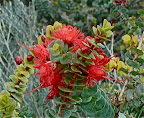The flower I should have started with is the Kangaroo Paw. I hope you enjoyed the Scarlet Featherflower sufficiently to forgive putting it ahead of the Kangaroo Paw, which is Western Australia’s state flower (they call it the state floral emblem here.) Specifically the Anigozanthos manglesii aka the Red and Green Kangaroo Paw is the state flower. The pic here is a mosaic at the entrance to the Botanic Garden that shows a representation of the Red and Green Kangaroo Paw.
For a flower to have red stems is unusual. For a flower to have green petals is very unusual. For a flower to have red stems and green flowers... well, you do the math.
I mentioned before that touching leaves here is often a surprise, but touching the Kangaroo paw parts yields about what you would expect if you were here to see the plant. The stem is fuzzy with millions of tiny hairs up and down it’s length. My Pics probably don’t capture it, but just imagine a very thin version of a cat tail head and that’s about what the red stem of the red and green kangaroo paw feels like.
The flower is pollinated by birds (of all things.) There are no bird pollinated plants in Europe, and the hummingbird is the only pollinating bird in the US. But here in Australia, about 17% of the plants are pollinated by birds ranging from the tiny honey eaters to the fairly large wattle bird.
The bird lands on the kangaroo paw stem and seeks nectar inside the tubular flower. When it does, the five stamens that make up the “paw” of the flower smack the bird on top of the head leaving pollen behind. When the bird visits the next flower.. well you get the picture. Interestingly, each species of Kangaroo Paw hits the bird in a slightly different place. This does not prevent cross pollination, as there are other characteristics that do that, but it does help conserve pollen by not wasting it where it cannot be utilized. These plants are pretty smart.
There are at least 8 species of Anigozanthos that I know of. Here is a pic of the Yellow Kangaroo Paw (Anigozanthus pulcherrimus.) Remember you can click on any pic to get a bigger version and be directed to my Picassa site where there is no telling what you might find. But there is also my favorite Kangaroo Paw, the Black Kangaroo Paw pictured below. Once again with green flowers, but a more pale green... and this time with BLACK STEMS. Whoever heard of a black stemmed flower?
The Black Kangaroo Paw is not in the same genus as the rest, which means it is really not closely related to the other types. Charles Darwin never visited Western Australia, but if he had, and if he had modern DNA testing technology, at least some of the points of his theories would have been different. Darwin, in order to support his ideas about all life stemming from a single ancestor, said that it is extremely unlikely that two separate species would ever develop similar methods of adapting to a habitat. Well, that doesn’t turn out to be true as is exemplified by the Black Kangaroo Paw which is in the genus Macropidia (Macropidia fuliginosa) instead of Anigozanthos, like the rest of the Kangaroo Paws. Can’t really hold him too responsible for the issue though because it probably does take DNA testing to figure it out.
So these are the Kangaroo Paws. You might see some similar species in the US called Cats Paws. Generally smaller than these, but similar looking.
M. Taylor



















